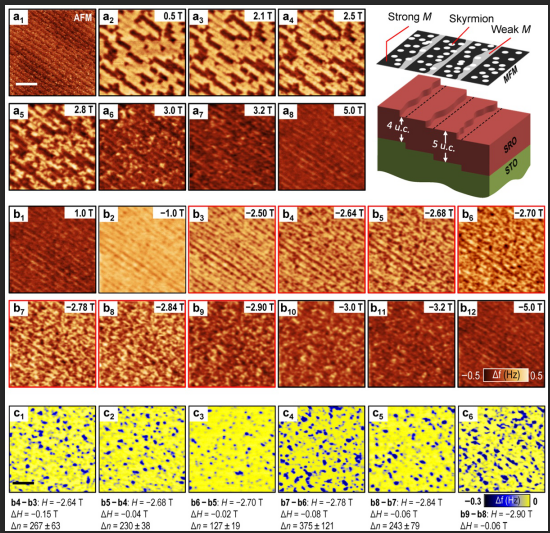A Chinese-Korean joint team observed the magnetic skyrmions in few layers oxide thin films, which had been measured by Hall Effect previousely but with its observation had never been realized.
In addition to its observation, the team also realized control of magnetic skyrmions in that ultrathin oxide hetero structures.
According to the team, they made the study through the low-temperature and high-magnetic-field magnetic force microscopy (or MFM) that was developed themselves.
The magnetic skyrmion is a whirled spin structure that is topologically protected and could be down to nanoscale. Besides, its particle-like dynamics and high mobility under driving current make it a popular candidate for the new generation information storage. This potential application places it into the spotlight, expecially with the coming of Information era.
However, due to its small size (typically in nanometer scale) and weak magnetism, Skyrmions have rarely been observed, especially in oxide thin films.
As for the recent achievement by the international joint team of Prof. LU Qingyou from High Magnetic Field Laboratory, Chinese Academy of Sciences (CHMFL) and Prof. Noh’s group in Seoul National University, the magnetic skyrmions was observed for the first time. And Nature Materials published their work.
In fact, Noh’s group previously explored possible magnetic skyrmions in the BTO/SRO thin films via Hall measurements.
However, to further confirm the existence of skyrmions, a direct microscale imaging is highly desired. So using MFM microscopy to push forward the study came to their mind.
Prof. LU Qingyou and his team in China performed MFM on the sample to conduct the study. And they obtained a series of possible skyrmions structures as various magnetic fields ranging from 5 T to -5 T.
To eliminate the unwilling background contrasts originating from the terrace edges, they performed pixel-by-pixel subtraction to every pair of MFM images with small magnetic field difference.
The resulting images showed clear individual skyrmions as well as skyrmion clusters or magnetic bubbles.
Through the MFM measurements, some fundamental information about skyrmions such as size, density, and dynamical behavior were also clearly revealed.
"Our work demonstrated the powerful ability of our home-made instrument" LU says, "We hope our work will attract more attention from researchers who work in the field of magnetic date storage and sensor technologies and seek for wider cooperation."
Link to the paper: Ferroelectrically tunable magnetic skyrmions in ultrathin oxide heterostructures

MFM images obtained as H sweeps from 0 to 5 T (a1-a8)and then from 5 to -5 T (b1-b12) after zero-field-cooling to 5 K. (c1-c6)MFM images obtained by the pixel-by-pixel subtraction. (Image by WANG Lingfei and FENG Qiyuan)
Contact:
ZHOU Shu
Hefei Institutes of Physical Science (http://english.hf.cas.cn/)
Email: zhous@hfcas.ac.cn
 Tel: +86-551-65591206
Tel: +86-551-65591206
 Fax: +86-551-65591270
Fax: +86-551-65591270
 Emai: zhous@hfcas.ac.cn
Emai: zhous@hfcas.ac.cn
 350 Shushanhu Road
350 Shushanhu Road